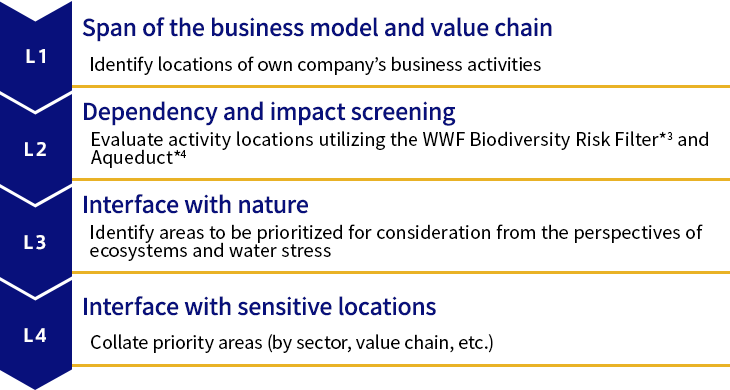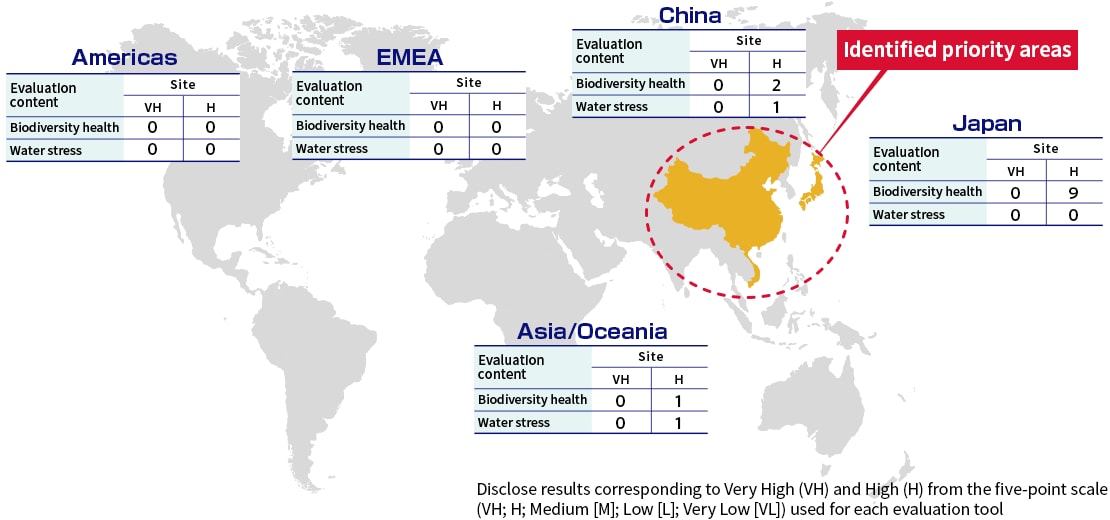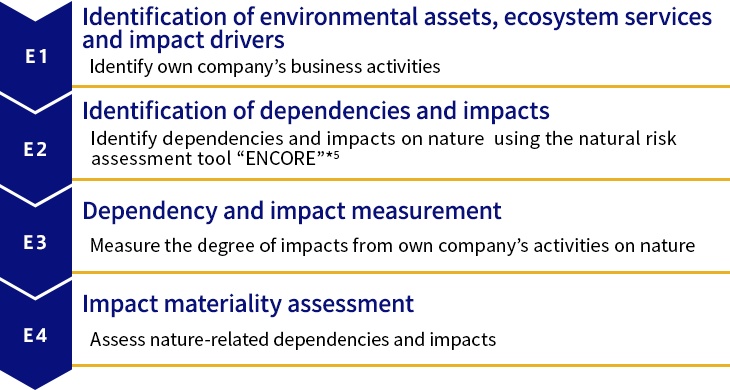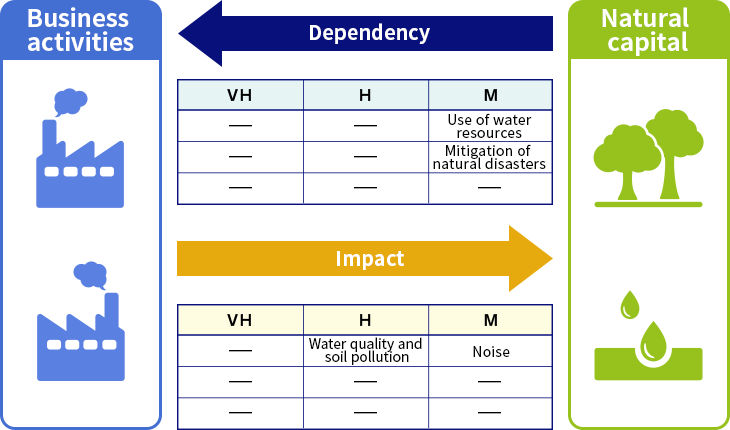Information disclosure based on the Taskforce on Nature-related Financial Disclosures (TNFD)
Based on its EHS policy, the Olympus Group actively promotes management of water utilization and wastewater as well as maintenance of green spaces at each of its business sites, in addition to cleanup, forest conservation, and tree planting activities in the vicinity of sites, as part of its biodiversity conservation activities.
In recent years, it has been pointed out that the deterioration of natural capital, including the land, sea, freshwater environments, and atmosphere that encompass biodiversity, has potentially grave impacts on the environment, society, and economic activities, with the importance of promoting the conservation of natural capital becoming even greater. Moreover, methods for confirmation of dependencies and impact on natural capital as well as methods for assessment of the risks and opportunities in business have become established. These methods include the Locate, Evaluate, Assess, and Prepare (LEAP*1) approach as outlined in the Taskforce on Nature-related Financial Disclosures (TNFD*2) disclosure framework, and have enabled more scientific assessments and measures to be implemented.
To the background of these developments, the Olympus Group has begun to conduct assessments in accordance with the LEAP approach to facilitate the promotion of more appropriate measures for natural capital in our business activities. In FY2025, we investigated and conducted assessments of the “Locate” and “Evaluate” stages of the LEAP approach, targeting major manufacturing and development sites. Going forward, we will endeavor to identify measures through further analysis and to enhance information disclosure.
*1 An integrated approach developed by the TNFD for assessing issues pertaining to nature, such as interfaces with and dependencies on and impacts of nature, as well as nature-related risks and opportunities
*2 An international organization that develops frameworks for appropriately assessing and disclosing risks and opportunities relating to natural capital and biodiversity in corporate activities. (Source: Ministry of the Environment)

Locate: Locate the Interface with Nature
Business activities have direct and indirect relationships with natural capital, such as water resources, soil, and the ecosystems present in the regions and sites where operations are implemented. For this reason, it is vital to first accurately identify the interfaces between business activities and natural capital, and then clearly collate the areas requiring priority responses to facilitate the sustainable utilization and conservation of natural capital.
At the Locate phase, we identified priority areas and sites based on factors such as ecosystems and water stress.

*3 A tool developed by the WWF to identify biodiversity risks in the value chain. The state of biodiversity health refers to a state in which natural systems maintain a good balance and where all biological organisms and the environment are functioning properly
*4 A global tool for assessing water risk developed by the World Resources Institute (WRI), which assesses water risk in the regions where sites are located from the perspectives of water quantity, water quality, regulations, and reputation
Evaluation results
As shown in the table below, Japan, China, and the Asia-Oceania region were identified as areas that require particularly urgent attention in terms of risks related to natural capital. Meanwhile, no areas with significantly high risk of water stress were identified.

Evaluate: Dependencies and Impacts
Business activities are supported by a diverse range of benefits derived from natural capital, such as water resources, soil, and air.
Establishing an accurate understanding of the natural capital which our business depends on and the impacts on from our business as well as undertaking the necessary management and instituting the necessary countermeasures are vital in allowing us to continue to enjoy the benefits of this natural capital into the future.
At the Evaluate phase, we assessed our natural capital “dependencies” and “impacts” in our business activities and identified areas necessitating a focus on analyses of the risks and opportunities.

*5 A nature-related risk analysis tool provided by Natural Finance Alliance
Evaluation results
The Olympus Group conducted an initial evaluation of its dependencies on and the impacts on natural capital in its business activities.
No elements were identified with Very High (VH) or High (H) dependencies on natural capital. Meanwhile, “water resource utilization” and “natural disaster mitigation” were identified as Medium (M) dependencies. Water resources are used in cleaning and cooling processes of product manufacturing, and as such are an essential element in ensuring product quality and safety. In addition, for the mitigation of natural disasters, regional disaster prevention and mitigation to reduce the risk of floods and landslides play an important role from the perspective of ensuring stable operations at production and development sites.
Meanwhile, for impacts on natural capital, no impacts were identified as corresponding to the VH level. Nevertheless “water quality and soil contamination” was identified as a factor with the potential to have a major impact, and “noise” was identified as having impacts equivalent to the M level. Specifically, wastewater from production processes has the potential to have impacts on the quality of public water area and soil; while noise created by production equipment has the potential to have impacts on the surrounding environment.

Current measures related to identified impacts
The Olympus Group is striving to prevent pollution through the introduction of wastewater purification treatment equipment and by conducting regular water quality and soil monitoring. In addition, for noise, we are also undertaking initiatives to minimize our impact on the surrounding environment through the installation of soundproofing equipment; adjustments to equipment operating hours; and initiatives for the regular measurement of noise levels.

